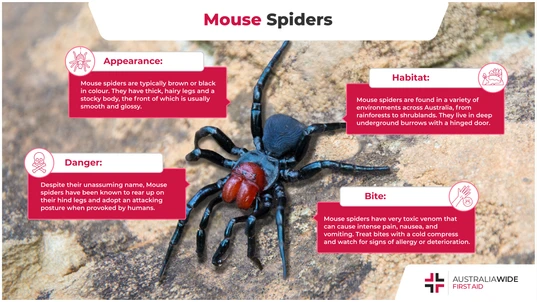Spider Facts: The Mouse Spider

Bites and Stings

Though they have an unassuming name, Mouse spiders should not be underestimated. They are distributed across mainland Australia. And similar to Funnel-web spiders, they live deep underground and can deliver nasty bites.
A type of trapdoor spider, Mouse spiders are found throughout mainland Australia and primarily reside in drier, arid environments such as the desert and coast. They are often mistaken for Funnel-web spiders due to their similarities in colour, size, and hunting habits.All about the Mouse spider
Commonly known as the ‘Mouse spider’, the Missulena is a genus of mygalomorph spiders that are indigenous to mainland Australia, though some can be found in parts of Chile. The name ‘Mouse spider’ originated from the belief that these spiders would dig deep burrows similar to those of mice as a means of providing shelter and safety from potential predators and prey. Found all over Australia, Mouse spiders inhabit a range of environments, from open rainforests to arid shrublands. They live in deep underground burrows covered by a hinged top or trapdoor. These burrows can extend to a depth of 12 inches, and they provide low humidity levels and high temperatures - the ideal conditions for a Mouse spider. Male Mouse spiders are known to wander from their burrows in search of mates. Females, meanwhile, tend to take comfort in their burrows and spend most of their lives underground. You are only likely to encounter a female Mouse spider if you accidentally dig one up, or if they are flooded from their burrows during heavy rains. Due to their sensitivity to vibrations, Mouse spiders can detect any subtle movements within proximity of their trapdoor.Identifying a Mouse spider
Mouse spiders are medium to large spiders that are dark in colour, stocky, and have hair on their legs. Female Mouse spiders tend to average 3 centimetres in length, while their male counterparts tend to be 2 centimetres long. Mouse spiders are often mistaken for Funnel-web spiders due to their similarities in hunting patterns (i.e., burrowing a hole deep in the ground) and physical identifiers. Here are some other identifiers typical of mouse spiders:- Long legs and long palps (appendage usually found near the mouth). Palps help spiders sense and interact with objects they encounter.
- Commonly black or brown in colour. Females are almost always black, while males tend to have species-specific colouration (e.g., Male eastern Mouse spiders often have a blue patch on the front of their abdomen, while male Red-headed mouse spiders often have a bright red head and jaws).
- Short, stocky, and thick legs.
- Glossy and smooth carapace with the eyes spread out at the front.
- Short spinnerets located near the abdomen. The spinneret is the silk-spinning organ of a spider.
Mouse spiders and their hunting habits
Compared to other burrow-dwelling spiders, Mouse spiders a bit unique in that their burrows have two surface trapdoors that are organised almost at right angles to each other. The trapdoors are made from a mixture of silk and soil, and so are very hard to see at first. According to the Australian Museum, having two doors may be a hunting strategy to increase the efficiency and probability of catching prey. Mouse spiders are nocturnal hunters – under the cover of nightfall, they attack their prey from their lidded burrows. The trapdoors are rigged with several trip wires that help alert the spider of approaching prey. Once a Mouse spider is alerted of potential prey passing their trapdoor, they lunge from their burrow and use their powerful jaws and poisonous venom to subdue the prey. Mouse spiders primarily feed on small insects such as wasps, centipedes, scorpions, ants, beetles, and other spiders. If the opportunity presents itself, they may occasionally prey on smaller animals such as small lizards and frogs.Are Mouse spiders dangerous to humans?
Despite their unassuming name, Mouse spiders are not to be underestimated. Some Mouse spiders have very toxic venom akin to the Funnel-web spider. However, there are very few cases of serious injury resulting from a Mouse spider bite. Likewise, Mouse spiders tend to only display aggression towards humans when provoked – and even then, it is believed that Mouse spiders use less venom and possibly give ‘dry’ bites (non-venomous bites). Nevertheless, it is important to take precautions when trekking through forests or among arid and dry bushland. Mouse spider bites have similar symptoms to those of a Redback spider, including:- Intense pain around the bite area
- Nausea
- Vomiting
- Abdominal pain
- Sweating
- Restlessness
- Palpitations
- Fever
- Muscle spasms

Mouse spiders are often mistaken for Funnel-web spiders, as they both live in lidded burrows, and they both have stocky, dark-coloured bodies. Likewise, both spiders deliver bites that can cause nausea, vomiting, and abdominal pain.
First aid for Mouse spider bite
Mouse spider bites should be treated in the same manner as a Funnel-web spider bite, as there are approximately 40+ varieties of large black spiders, so it is worthwhile to treat for the worst and hope for the best:- Keep the casualty at rest and as still as possible to stop the venom from travelling through the body.
- Constantly observe and reassure the casualty.
- Follow DRSABCD and be prepared to perform CPR
- Apply the ‘pressure immobilisation technique’ (PIT):
If the bite site is on a limb, cover it with a wide heavy elastic bandage (10 - 15 cm wide).
Ensure the bandage is firm and tight, so tight you cannot easily slide a finger between the bandage and the skin.
Apply a second heavy elastic bandage. Start from the fingers or toes and wind up the limb as far as possible. Consistent coverage (overlapping half over half) and consistent pressure (firm but not cutting off circulation) are key to an effective PIT. - Immobilise the limb and joints with a splint, or use a sling if the bite site is on an arm. Keep the limb immobilised until the ambulance arrives.
Spider bites and anaphylaxis
Some people can have a severe allergic reaction when bitten by a spider. This is called anaphylaxis, a condition that can be fatal in as little as 15 minutes. Symptoms include:- Tightness of the throat from swelling.
- Difficulty breathing.
- Tongue and facial swelling.
- Hoarse voice or difficulty speaking.
- A wheeze or persistent cough.
- Collapse or falling unconscious.
- Becoming pale or floppy (young children).
- Abdominal pain and vomiting.
- Hives, welts, and body redness.
Fun facts about the Mouse spider
- Male Mouse spiders reach sexual maturity after 4 years.
- Unlike other mygalomorph spiders, Male mouse spiders tend to wander from their burrows during the day in search of mates, as opposed to wandering during the night.
- Female mouse spiders can lay 60 or more eggs within one egg sac.
- Males are often encountered towards the end of summer, from April to May.
- Mouse spiders often fall into suburban swimming pools.
- Mouse spiders tend to rear up on their hind legs when they feel threatened.
Final thoughts
The likelihood of encountering a Mouse spider is very low – although they are scattered all over mainland Australia, they rarely occur in densely populated areas. In saying that, Mouse spiders are not to be taken lightly, and you should learn as much as you can about them. To learn even more about how to prevent, identify, and treat Mouse spider bites, book a First Aid course with us today. Knowing how to effectively deliver first aid in the event of any bite or sting could one day save a life.Recommended resources
Our Resource Library is brimming with resources on how to identify and treat a wide variety of bites and stings. For instance, we have articles on what to do if you get stung or bitten by a snake, a fire ant, and different types of marine life. Our article on spider bites also does a deep dive on how to identify and treat bites from some of Australia's deadliest spiders, including the Wolf spider, the Huntsman spider, the White tail spider, and the Redback spider. Disclaimer: This article is for informational purposes only. It does not constitute, replace, or qualify as any form of first aid training.
Originally published at
https://www.australiawidefirstaid.com.au/resources/the-mouse-spider
as part of the Australia Wide First Aid Articles Library









